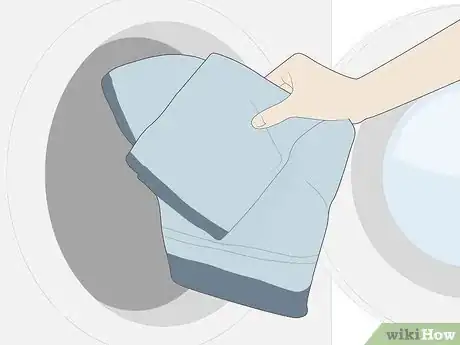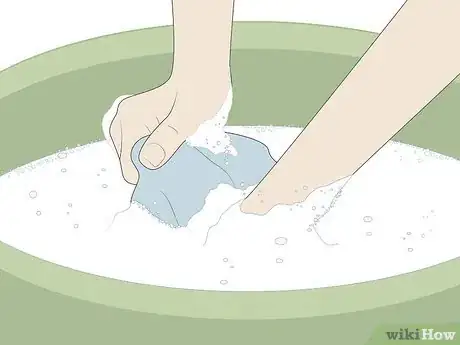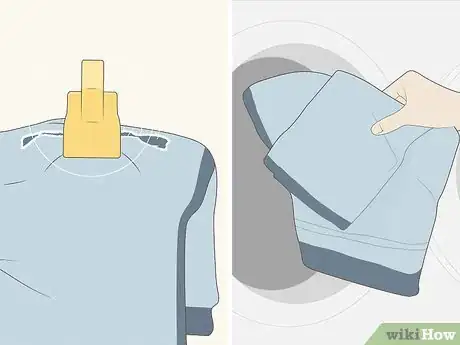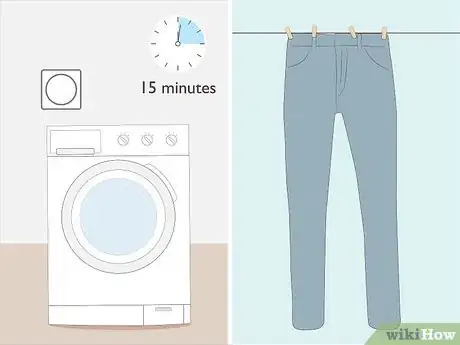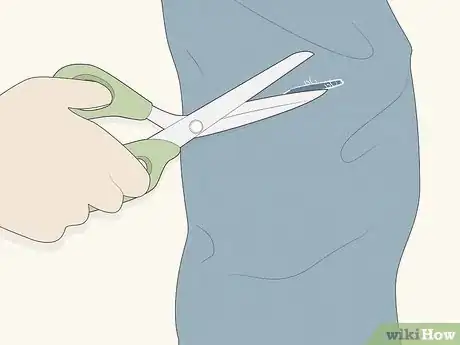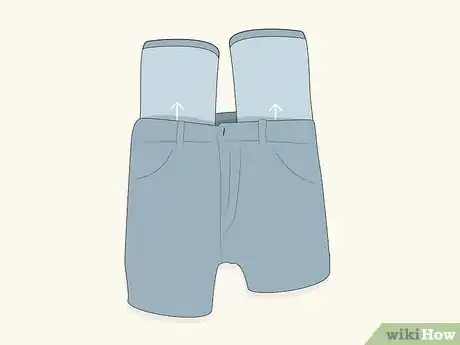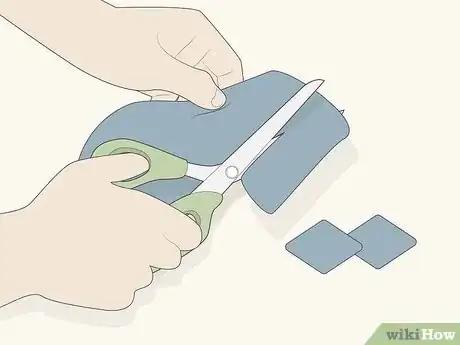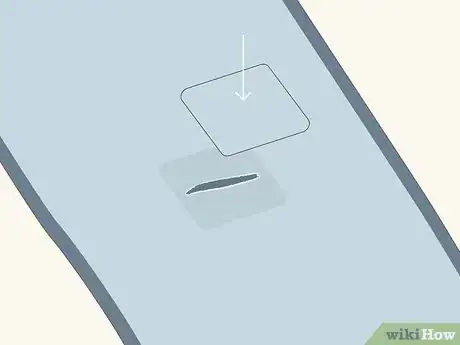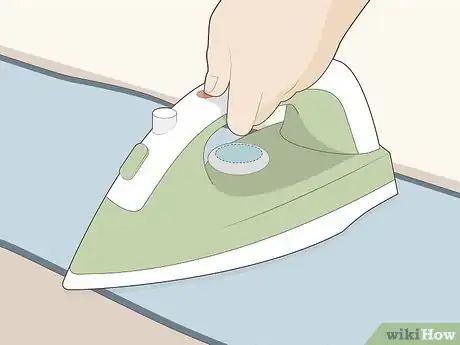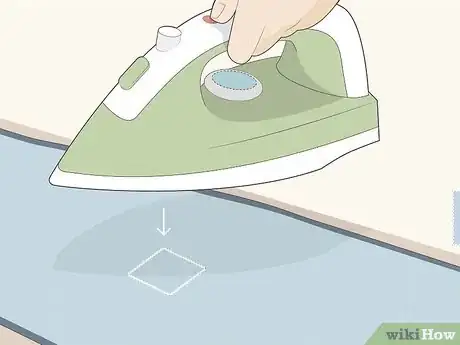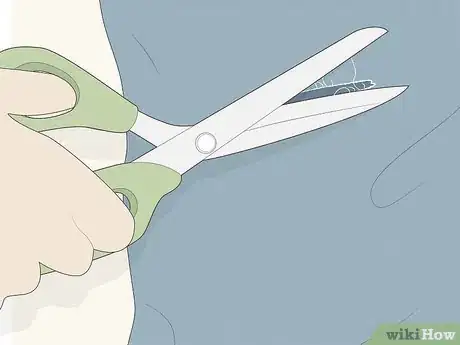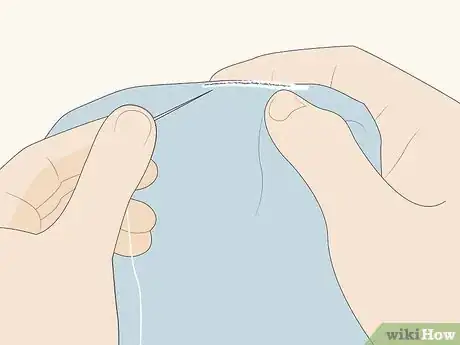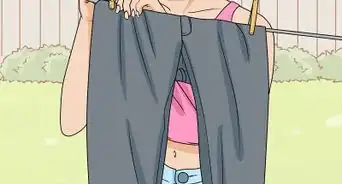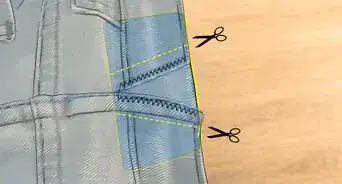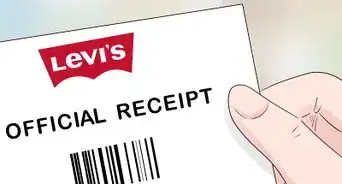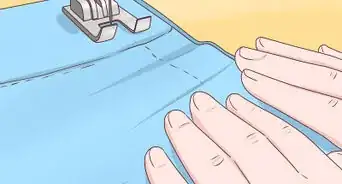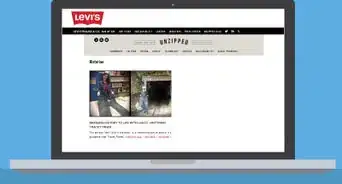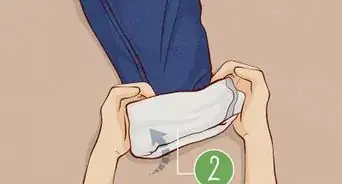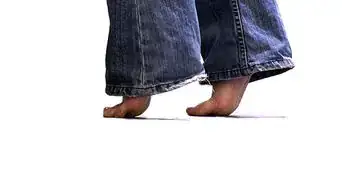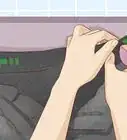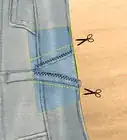This article was co-authored by Kamel Almani and by wikiHow staff writer, Janice Tieperman. Kamel Almani is a Laundry and Cleaning Specialist and the Co-Owner of WashyWash, a toxin-free and eco-friendly laundry and dry clean service based in Amman, Jordan. Kamel and his staff at WashyWash use Blue Angel certified and dermatologically-tested detergents. They also combine EcoClean and digital technology to provide an eco-friendly, convenient, and quality cleaning service. Kamel holds a BA in Design from the University of Applied Science, Amman.
There are 8 references cited in this article, which can be found at the bottom of the page.
This article has been viewed 25,387 times.
Ripped jeans can be used to create a variety of looks, but it’s not ideal when these torn sections begin to fray around the edges. While there’s not a lot of ways to stop fraying from happening, you can prevent it by taking care of your jeans whenever they start to smell.[1] If you’re looking for a more permanent solution to fix your jeans, try experimenting with iron-on patches or white thread, which can add more security to the ripped edges of your jeans.
Steps
Minimizing Damage during Cleaning
-
1Wash your jeans once they start smelling bad. If you wear your ripped jeans a lot, set a rough laundry schedule for them. While your ripped jeans don’t have to be laundered each time you wear them, you need to wash your jeans whenever they become visibly dirty. If you keep your jeans in great condition, they won’t be as likely to fray.[2]
-
2Hand wash your jeans to prevent your frays from getting worse. Fill a large tub with cool water, then stir in a pea-sized amount of laundry detergent. Soak your jeans in the soapy water for at least 15 minutes to remove any dirt or grime from the denim. To rinse them off, refill your basin with clean water and dunk your jeans multiple times. Afterwards, arrange them on a flat surface or clip them on a clothesline so they can air-dry.[3]
- Hand washing is the safest way to clean your ripped jeans, as you’re less likely to agitate the fraying edges.
Advertisement -
3Clip the ripped portions of your jeans if you use a washing machine. Turn your jeans inside-out, then find the ripped portions. Use a pair of sock clips to hold the frayed portions together so they’re less likely to be agitated in the washer. Additionally, make sure that your zippers and buttons are secured and fastened before starting the wash cycle.[4]
- You can purchase sock clips online.
-
4Machine wash your jeans on a delicate, cold water cycle. Choose a color-preserving laundry detergent that’s designed for dark-colored garments. Place your clipped, zipped jeans in the washing machine, then adjust the cycle to have cold water and a delicate cycle. Try to choose a short wash cycle so your ripped jeans don’t get agitated while in the wash.[5]
-
5Tumble dry jeans on low for 15 minutes before air-drying them. Keep your jeans inside-out and place them in your tumble dryer with 2-3 dryer balls. Once the drying cycle ends, turn your jeans right-side-out and hang them in an open area. Try to rub away any obvious wrinkles from your jeans once they’re out of the dryer.[6]
- If your jeans are made with more than 3% spandex, consider hanging them up on a clothesline instead of placing them in a tumble dryer.
Reinforcing Rips with Iron-On Patches
-
1Snip away any fraying threads with scissors. Lay your jeans on a flat surface, flipping them to the side where the rips and fraying edges are visible. Use a pair of fabric scissors to trim away the fraying threads from the edge of the ripped denim so you can create a smooth, even edge.[7]
-
2Turn your jeans inside-out. Tuck your jean legs into the waistband area, then pull them out on the opposite end. Make sure that the inner portion of denim is visible, as this is the portion of fabric that you want to be working with later.[8]
- You’ll be applying the iron-on patches beneath the rips, not on top of them.
-
3Trim several iron-patches so they can surround the ends of the rip. Measure the ends of your tear to get an idea of how large or small your patches need to be. Use a pair of fabric scissors to trim the iron-on patches into smaller square or rectangular shapes. You’ll be placing this patch on the end of each tear to provide extra support.[9]
- For most rips, two 2 by 2 in (5.1 by 5.1 cm) patches should suffice.[10]
-
4Lay the patches on the ends of your rip. Position your patches along the areas where the fraying is especially bad, like the pointed ends of the tears. Arrange the patches so they overlap with the base of the tear, which can prevent future fraying and tearing in the future.[11]
- Don’t iron on your patches until you’re happy with their placement!
-
5Iron over the patches with the steam setting turned off. Keep your jeans inside-out and place them on an ironing board or other heat-resistant surface. Set your iron to medium heat with the steam turned off, or whatever the iron-on patch’s packaging specifies. Press the iron over the patches in long, even motions, applying consistent pressure throughout.[12]
- Always follow the recommended instructions before ironing. If you leave your iron on the denim for too long, you could end up burning or damaging the fabric.
- The iron helps the patches to adhere to the denim, which will provide support to your jeans.
-
6Use a zig-zag stitch to sew over the iron patches. Leave your jeans inside-out, then position the corner of the rip beneath the needle of your sewing machine. Select the zig-zag stitch setting and sew over the edge of denim and the iron patch. If you don’t have a sewing machine on hand, use a regular stitch to sew your jeans by hand.[13]
- Choose a thread color like white or blue that will match or compliment the color of your jeans.
- Consider sewing 3 rows of overlapping stitches along the edges of the rips to provide extra security.
-
7Rub the iron on the patches 1 more time. Turn your iron back onto the recommended temperature, then place an even amount of pressure over each iron-on patch. Go over all of the iron-on patches 1 more time to ensure that they’ve adhered to your jeans.[14]
- If you notice any extra threads hanging off, be sure to trim them.[15]
Sewing Rips Closed by Hand
-
1Cut off any fraying edges from your ripped jeans. Use a pair of fabric scissors to snip away any long threads that are hanging from the torn denim. Try to clip the threads close to the edge of the denim so you can have an easier time stitching and repairing the material.[16]
-
2Repair and close small rips with a needle and thread. Turn your jeans inside-out and find any small, golf ball-sized tears and frays within the material. Use your fingers to pinch the torn edges together. After this, use a needle and white thread to stitch these ripped portions together. Once you’ve finished, snip away any excess thread with a pair of fabric scissors.[17]
- With small tears and rips, it’s easier to repair them completely.
-
3Sew white thread across the fraying edges of larger rips. String a 1 to 2 ft (30 to 61 cm) section of thread on your needle, then begin looping the thread over and under the frayed edges of your jeans. Loop and stitch the thread in a large, back-and-forth motion, which helps create a naturally frayed look along your jeans. After stitching each loop, tie a knot around the thread to make it sturdier. Continue threading and looping until you’ve covered the entire ripped section of your jeans.[18]
- Try to keep your loops of thread close together, as this will make your ripped jeans look more authentic.
- This won’t sew your rips completely closed, but will provide reinforcement across the rip overall.
Expert Q&A
-
QuestionWhat other methods can you use to effectively stop fabric from fraying in the wash?
 Kamel AlmaniKamel Almani is a Laundry and Cleaning Specialist and the Co-Owner of WashyWash, a toxin-free and eco-friendly laundry and dry clean service based in Amman, Jordan. Kamel and his staff at WashyWash use Blue Angel certified and dermatologically-tested detergents. They also combine EcoClean and digital technology to provide an eco-friendly, convenient, and quality cleaning service. Kamel holds a BA in Design from the University of Applied Science, Amman.
Kamel AlmaniKamel Almani is a Laundry and Cleaning Specialist and the Co-Owner of WashyWash, a toxin-free and eco-friendly laundry and dry clean service based in Amman, Jordan. Kamel and his staff at WashyWash use Blue Angel certified and dermatologically-tested detergents. They also combine EcoClean and digital technology to provide an eco-friendly, convenient, and quality cleaning service. Kamel holds a BA in Design from the University of Applied Science, Amman.
Laundry & Cleaning Specialist You could also place the piece of clothing in a mesh bag before washing and hang the item to dry instead of using a drying machine.
You could also place the piece of clothing in a mesh bag before washing and hang the item to dry instead of using a drying machine.
Things You’ll Need
Minimizing Damage during Cleaning
- Detergent
- Sock clips
- Dryer balls
Applying Iron-on Patches
- Fabric scissors
- Iron-on patches
- Iron
- Sewing machine
- Needle
- Thread
- Flat iron (optional)
Sewing Rips Closed by Hand
- Fabric scissors
- Needle
- White thread
References
- ↑ https://www.businessinsider.com/how-often-you-should-wash-jeans-2016-3
- ↑ https://www.businessinsider.com/how-often-you-should-wash-jeans-2016-3
- ↑ https://www.esquire.com/style/advice/a44472/how-to-wash-your-jeans/
- ↑ https://www.goodhousekeeping.com/home/cleaning/tips/a24878/mistakes-washing-jeans/
- ↑ https://www.goodhousekeeping.com/home/cleaning/tips/a24878/mistakes-washing-jeans/
- ↑ https://www.goodhousekeeping.com/home/cleaning/tips/a24878/mistakes-washing-jeans/
- ↑ https://www.gq.com/story/the-best-way-to-fix-your-ripped-jeans
- ↑ https://m.youtube.com/watch?v=gIlws3bvLho&t=024s
- ↑ https://www.cleanipedia.com/gb/clothing-care/How%20to%20fix%20ripped%20jeans.html
- ↑ https://www.youtube.com/watch?v=gIlws3bvLho&t=024s
- ↑ https://www.gq.com/story/the-best-way-to-fix-your-ripped-jeans
- ↑ https://www.cleanipedia.com/gb/clothing-care/How%20to%20fix%20ripped%20jeans.html
- ↑ https://www.cleanipedia.com/gb/clothing-care/How%20to%20fix%20ripped%20jeans.html
- ↑ https://www.gq.com/story/the-best-way-to-fix-your-ripped-jeans
- ↑ https://www.cleanipedia.com/gb/clothing-care/How%20to%20fix%20ripped%20jeans.html
- ↑ https://www.cleanipedia.com/gb/clothing-care/How%20to%20fix%20ripped%20jeans.html
- ↑ https://www.cleanipedia.com/gb/clothing-care/How%20to%20fix%20ripped%20jeans.html
- ↑ https://simplory.com/the-best-way-to-fix-restore-your-ripped-jeans-to-look-new-again/
